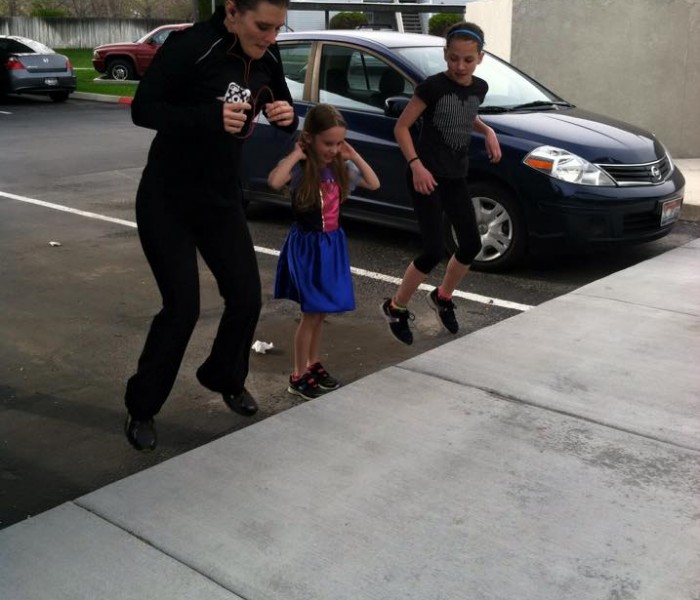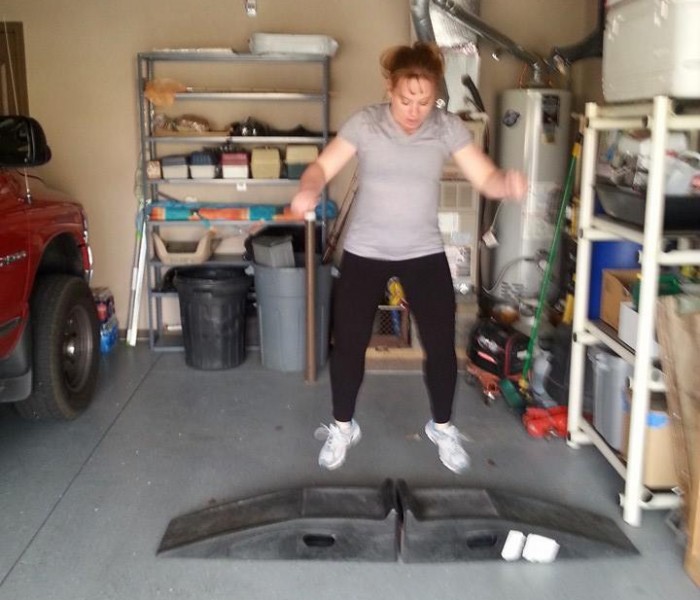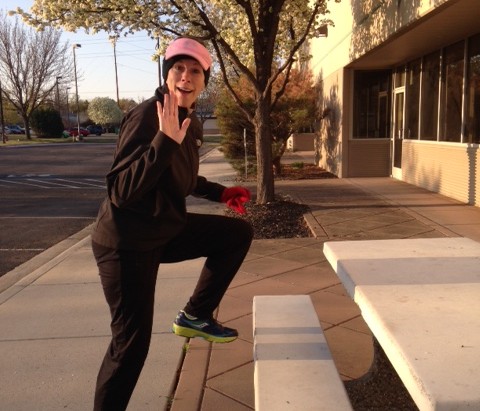This
post was originally published on
this sitehttps://www.girlsgonestrong.com/
Birth and motherhood have their share of ups and downs and, as fitness professionals and health professionals, we have an important role to play in a new mom’s physical wellbeing as well as her mental and emotional wellbeing. Very often, there are circumstances affecting a mom’s physical health after birth that impact upon her mental health, and by coaching her through this, we can have a profound impact on her overall quality of life.
Before I started working in women’s health and pelvic health physiotherapy, I hadn’t considered asking moms about the details of their birth (e.g. had the mom had any birth trauma?) In all honesty, I had never even come across pelvic organ prolapse before!
We now know that a mom’s birth experience can significantly affect the way she trains. Here are five important questions fitness professionals can ask when taking a new mom as a client:
1. What Type of Birth Did Your Client Have and Was There Any Birth Trauma?
The details of a mom’s birth can often be overlooked, but as a coach you are in a unique and important position to listen to and learn about a mom’s birth story. Because of this, you can help guide her exercise progression as well as make any necessary referrals.
It’s important to know what type of birth your client had, i.e. if she had a vaginal delivery or a Cesarean section. Remember that, for many women, there is still a stigma around C-sections, so it’s important to be mindful and sensitive about this, as well as to remind your client that there is no shame in any type of birth.
Birth is birth, whether the baby exited from the vagina or from the abdomen.
If a woman has had a C-section, there are a number of things you will need to consider, such as the impact the incision may have on movement and on her core stabilizer muscles, particularly her breathing diaphragm and her transversus abdominis muscle. You will need to investigate how her incision scar is healing and whether she has been cleared to exercise at her six-week check.
If a woman has had a vaginal delivery, there a few more sensitive things you will need to consider, such as if she had a traumatic birth. This could be an emotionally or physically traumatic birth, or both. An important question to ask is if she had an assisted vaginal delivery, i.e. were any forceps or vacuum used, as this increases her risk of having some type of birth injury [1,2].
You should also find out if the new mom experienced vaginal or perineal tearing. If she reports third or fourth degree tears, you will need to check if she has seen a pelvic health or women’s health physiotherapist/physical therapist as this is classified as obstetric anal sphincter injury, and warrants a referral.
2. Does Your Client Have Any Bladder or Bowel Control Problems?
Regardless of whether the birth was traumatic or not, a new mom may experience issues such as incontinence or changes in her bladder and bowel function, and chances are she hasn’t discussed this with anyone. This could either be because she is embarrassed that she is leaking, or it could be because she has been led to believe that leaking after birth is “normal”.
As a coach, it important to listen and advise your client that incontinence after birth is common, but is never normal.
In the US, approximately 50 percent of women are affected by urinary incontinence and approximately 9 percent of women are affected by fecal incontinence [3,4].
Either urinary or fecal incontinence can be signs of pelvic organ prolapse, so it is essential that this is diagnosed, as you will need to modify your client’s exercise program accordingly. Fecal incontinence could also be a sign of obstetric anal sphincter injury, and weakness in the anal sphincter muscles. It is important to refer any woman who reports incontinence to a pelvic health physiotherapist for an assessment and targeted management plan.
When training new moms, remember to instruct them to advise you as soon as they experience any bladder or bowel control problems, especially if it is during the training session or afterwards. It is never acceptable to continue through the exercise if she is experiencing symptoms. This is a sign that either her muscles, such as the pelvic floor muscles, are fatigued, or that there is another underlying issue, like pelvic organ prolapse.
 3. Does Your Client Have Diastasis Rectus Abdominis?
3. Does Your Client Have Diastasis Rectus Abdominis?
With almost all pregnant women developing some degree of diastasis rectus abdominis (DRA) by the end of their pregnancy, it is important to check if your client still has DRA, especially since 40 percent of women still have DRA at six months postpartum [5]. Many new moms are concerned about the appearance of their stomachs, as well as the presence of an abdominal separation.
66 percent of women with DRA will also have at least one related pelvic floor dysfunction, such as urinary incontinence, fecal incontinence or pelvic organ prolapse [6]. By assessing for DRA, you can ensure that the training program you create for your client will improve her abdominal wall impairments and encourage the use of the core muscles.
In a client with DRA, incontinence, or pelvic organ prolapse, it is necessary to train her core stability muscles, including her breathing diaphragm, pelvic floor, transversus abdominis and multifidus. You are ideally placed to improve the stability and strength through her abdomen and pelvis, thereby reducing the effects of the DRA.
4. Does Your Client Experience Any Pain?
Approximately 50 percent (and up to 90 percent) of pregnant women experience back pain, pelvic girdle pain, genito-pelvic pain, or any combination of the three [7,8]. Women may continue to experience pain after birth, and women may also develop pain after birth. Your client’s training program needs to cater for this, without worsening her pain.
Back pain and incontinence have also been shown to be related in pregnancy and post-birth, and research suggests this is due to the contribution of the trunk muscles to continence and lumbopelvic control [9]. As a fitness professional, your training program is crucial in strengthening the woman’s muscles to help her overcome her back and pelvic pain as well as her incontinence.
The appropriate activation of the deep stabilizing muscles in synergy with the global muscles must be integrated into the client’s training program. This includes the client’s ability to use her breathing diaphragm throughout the workout as well as her pelvic floor, transversus abdominis and multifidus during exercises.
Back pain, pelvic pain, and particularly genito-pelvic and sexual pain can be associated with a pelvic floor that is non-relaxing or overactive, rather than a weak pelvic floor. In these cases, you should refer your client to a pelvic health physiotherapist for further assessment and treatment.
 5. Has Your Client Exercised Before?
5. Has Your Client Exercised Before?
You should of course consider if your client has exercised before or during pregnancy, and what type of exercise she has done, as well as what type of exercise she wishes to return to. This will help guide your exercise programming so that she can reach her goals efficiently.
Remember to ask your client if she has ever done pelvic floor exercises or transversus abdominis exercises before seeing you. If not, or if she doesn’t do them correctly, you will need to teach her the basics of diaphragmatic breathing and engaging these core muscles before proceeding on to strength training.
As a fitness professional working with new moms, this may seem like a lot of information to consider. However, asking these questions will ensure that your client will be able to progress her exercise program safely and effectively. Working alongside a pelvic health physical therapist and making the necessary referrals will ensure that your clients have had appropriate pelvic floor and pelvic organ prolapse assessment, as this will help guide your client’s training program.
Encourage all new moms to have a pelvic floor assessment done with a pelvic health physical therapist at six to eight weeks postpartum or whenever possible. With new moms an “inside-out” approach is best.
References
- Caudwell-Hall J, Kamisan Atan I, Martin A, et al. Intrapartum Predictors of Maternal Levator Ani Injury. Acta Obstetricia et Gynecologica Scandinavica. April 2017; 96(4): 426-431. https://www.ncbi.nlm.nih.gov/pubmed/28117880
- Gardella C, Taylor M, Benedetti T, Hitti J, Critchlow C. The effect of sequential use of vacuum and forceps for assisted vaginal delivery on neonatal and maternal outcomes. American Journal of Obstetrics and Gynecology. October 2001; 185(4): 896-902. https://www.ncbi.nlm.nih.gov/pubmed/11641674
- Markland AD, Richter HE, Fwu CW, Eggers P, Kusek JW. Prevalence and trends of urinary incontinence in adults in the United States, 2001 to 2008. Journal of Urology. August 2011; 186(2): 589-593. https://www.ncbi.nlm.nih.gov/pubmed/21684555
- Whitehead WE, Borrud L, Goode PS, et al. Fecal incontinence in US adults: epidemiology and risk factors. Journal of Gastroenterology. August 2009; 137(2): 512-517. https://www.ncbi.nlm.nih.gov/pubmed/19410574
- Fernandes da Mota PG, Pascoal AG, Carita AI, Bo K. Prevalence and Risk Factors of Diastasis Recti Abdominis from Late Pregnancy to 6 Months Postpartum, and Relationship with Lumbo-Pelvic Pain. Manual Therapy. February 2015; 20(1): 200-205.
https://www.ncbi.nlm.nih.gov/pubmed/25282439
- Spitznagle TM, Leong FC, Van Dillen LR. Prevalence of Diastasis Recti Abdominis in a Urogynecological Patient Population. International Urogynecology Journal Pelvic Floor Dysfunction. March 2007; 18(3): 321-328. https://www.ncbi.nlm.nih.gov/pubmed/16868659
- Katonis P, Kampouroglou A, Aggelopoulos A, et al. Pregnancy-Related Low Back Pain. Hippokratia. July 2011; 15(3): 205-210. https://www.ncbi.nlm.nih.gov/pmc/articles/PMC3306025/
- Glowacha M, Rosen N, Chorney J, Snelgrove Clarke E, George RB. Prevalence and Predictors of Genito-Pelvic Pain in Pregnancy and Postpartum: The Prospective Impact of Fear Avoidance. Journal of Sexual Medicine. December 2014; 11(12): 3021-3034.
https://www.ncbi.nlm.nih.gov/pubmed/25124648
- Smith MD, Russell A, Hodges PW. Is There a Relationship Between Parity, Pregnancy, Back Pain and Incontinence? . International Urogynecology Journal Pelvic Floor Dysfunction. February 2008; 19(2): 205-211. https://www.ncbi.nlm.nih.gov/pubmed/17665083
The post 5 Important Considerations When Training New Moms appeared first on Girls Gone Strong.






 For now classes are 6pm and 640pm at 2840 Wildwood st in the Boise Cloggers studio.
Book your class NOW!
click this ==>
For now classes are 6pm and 640pm at 2840 Wildwood st in the Boise Cloggers studio.
Book your class NOW!
click this ==>








